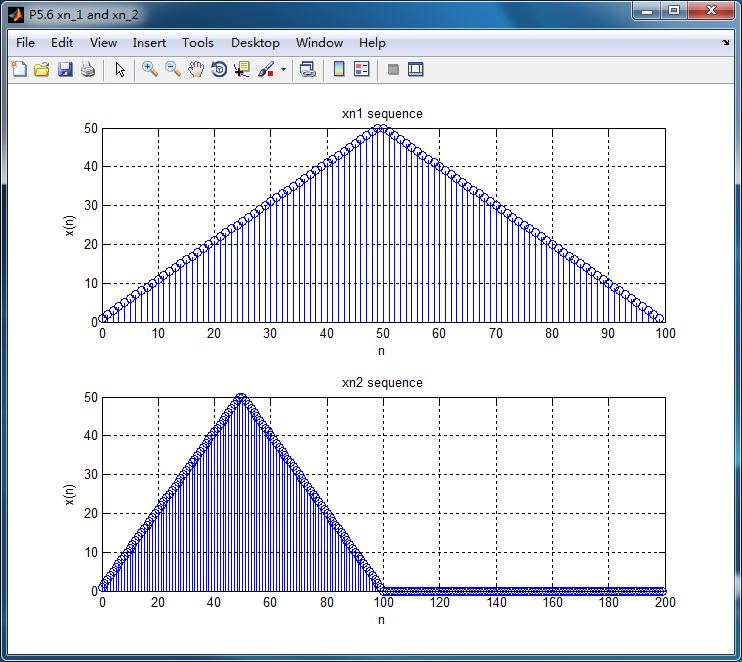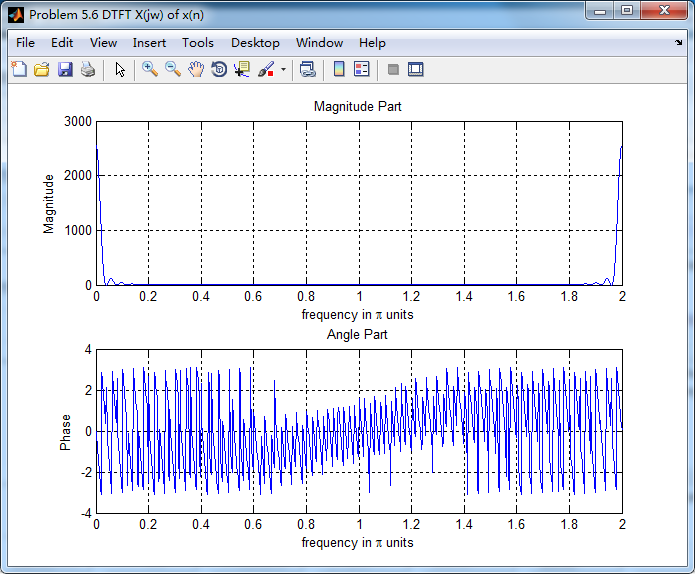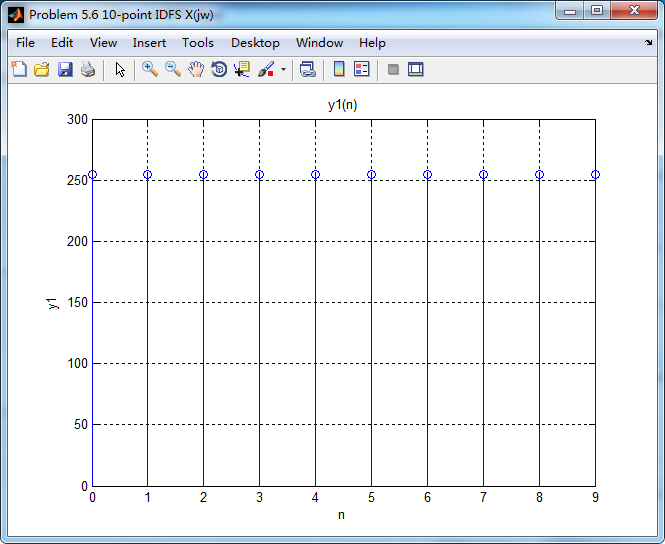
频率采样定理是这样的:

由上述定理可知,一个有限长序列(假设为N)的DTFT等间隔采样,采样数至少大于等于N。
代码:
%% ++++++++++++++++++++++++++++++++++++++++++++++++++++++++++++++++++++++++++++++++
%% Output Info about this m-file
fprintf('
***********************************************************
');
fprintf(' <DSP using MATLAB> Problem 5.6
');
banner();
%% ++++++++++++++++++++++++++++++++++++++++++++++++++++++++++++++++++++++++++++++++
% --------------------------------------------------
% 1 x(n) = n + 1 n=[ 0:49]
% = 100-n n=[50:99]
% = 0 otherwise
% --------------------------------------------------
L = 50; n = [0:L-1]; N = 100; %k1 = [0 : N-1]; % wave parameters
xn_1 = [n+1, 100-(n+50)]; % length 100
xn_2 = [xn_1, zeros(1,100)]; % padding 100 zeros
figure('NumberTitle', 'off', 'Name', 'P5.6 xn_1 and xn_2')
set(gcf,'Color','white');
subplot(2,1,1); stem([0:N-1], xn_1);
xlabel('n'); ylabel('x(n)');
title('xn1 sequence'); grid on;
subplot(2,1,2); stem([0:length(xn_2)-1], xn_2);
xlabel('n'); ylabel('x(n)');
title('xn2 sequence'); grid on;
% -------------------------------------------------------------
% X(jw), DTFT of x(n)
% -------------------------------------------------------------
MM1 = 500;
%k = [-MM : MM]; % [-pi, pi]
%k = [0:MM]; % [0, pi]
%w = (2*pi/MM) * k;
[X1, w1] = dtft1(xn_1, [0:N-1], MM1);
%[X] = dtft(xn_1, [0:N-1], w);
magX1 = abs(X1); angX1 = angle(X1); realX1 = real(X1); imagX1 = imag(X1);
figure('NumberTitle', 'off', 'Name', 'Problem 5.6 DTFT X(jw) of x(n)');
set(gcf,'Color','white');
subplot(2,1,1); plot(w1/pi, magX1); grid on;
title('Magnitude Part');
xlabel('frequency in pi units'); ylabel('Magnitude');
subplot(2,1,2); plot(w1/pi, angX1); grid on;
title('Angle Part');
xlabel('frequency in pi units'); ylabel('Phase');
figure('NumberTitle', 'off', 'Name', 'Problem 5.6 Real and Imag of X(jw)');
set(gcf,'Color','white');
subplot('2,1,1'); plot(w1/pi, realX1); grid on;
title('Real Part');
xlabel('frequency in pi units'); ylabel('Real');
subplot('2,1,2'); plot(w1/pi, imagX1); grid on;
title('Imaginary Part');
xlabel('frequency in pi units'); ylabel('Imaginary');
%% -----------------------------------------------------------------------
%% 10-point frequency sample of X(w), DTFT of xn1 sequence
%% then IDFS to get y1(n)
%% -----------------------------------------------------------------------
y1 = real( idfs( X1(1:100:1000), 10) );
figure('NumberTitle', 'off', 'Name', 'Problem 5.6 10-point IDFS X(jw)');
set(gcf,'Color','white');
%subplot(2,1,1);
stem([0:9], y1); grid on;
title('y1(n)');
xlabel('n'); ylabel('y1');
%% -----------------------------------------------------------------------
%% 200-point frequency sample of X(w), DTFT of xn1 sequence
%% then IDFS to get y2(n)
%% -----------------------------------------------------------------------
y2 = real( idfs(X1(1:5:1000), 200) );
figure('NumberTitle', 'off', 'Name', 'Problem 5.6 200-point IDFS X(jw)');
set(gcf,'Color','white');
%subplot(2,1,1);
stem([0:199], y2); grid on;
title('y2(n)');
xlabel('n'); ylabel('y2');
%% -----------------------------------------------------------------------
%% 100-point frequency sample of X(w), DTFT of xn1 sequence
%% then IDFS to get y3(n)
%% -----------------------------------------------------------------------
y3 = real( idfs(X1(1:10:1000), 100) );
figure('NumberTitle', 'off', 'Name', 'Problem 5.6 100-point IDFS X(jw)');
set(gcf,'Color','white');
%subplot(2,1,1);
stem([0:99], y3); grid on;
title('y3(n)');
xlabel('n'); ylabel('y3');
运行结果:
原始序列,长度为N=200,但是只有前100个元素不为零,可以看成长度为100的序列末尾补了100个零。

[-2π,2π]范围内的DTFT

[0,2π]范围内的DTFT

DTFT进行10等分采样,然后IDFS变换得到序列y1

DTFT进行200等分采样,然后IDFS变换得到序列y2

DTFT进行100等分采样,然后IDFS变换得到序列y3

由上图可知,y3(100等分DTFT再逆变换)与原始序列的非零部分相同,y2(200等分DTFT再逆变换)与原始序列完全相同,y1有畸变。